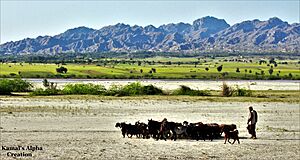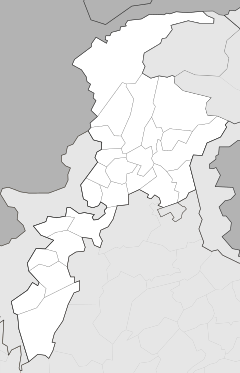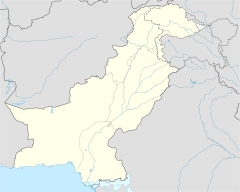Lakki Marwat facts for kids
Quick facts for kids
Lakki Marwat
لکی مروت
|
|
|---|---|
|
District Headquarter / City
|
|
| District Lakki Marwat | |
 |
|
| Country | Pakistan |
| Province | Khyber Pakhtunkhwa |
| District | Lakki Marwat District |
| Government | |
| • Type | Tehsil-council |
| Elevation | 255 m (837 ft) |
| Population
(2017)
|
|
| • Total | 59,465 |
| Time zone | UTC+5 (PST) |
| Calling code | 0969 |
| Number of Union councils | 2 |
Lakki Marwat, often called just Lakki, is an important city in the Khyber Pakhtunkhwa province of Pakistan. It's the main city of the Lakki Marwat District. Lakki Marwat is growing quickly and is one of the 20 largest cities in its province.
Contents
History of Lakki Marwat
Early Beginnings
Lakki was first known as "Thal Daman," which means an open, sandy plain. One of the earliest signs of people living here and the spread of Islam in the nearby area of Bannu comes from graves of important religious figures found near the Kurram River. Old historians also wrote about Bannu. For example, Al-Baladuri wrote in 664 AD about a war that reached "Banna" (Bannu) and "Alahwar" (Lahore), which were between Multan and Kabul.
Mughal and Durrani Rule
The Mughal Emperor Babur mentioned the tribes of Lakki Marwat in his writings. When he visited Bannu in 1505, he noted that the Niazis lived in the area now known as Marwat. Later, around 1602, the Niazis were moved out by the Marwat tribe towards Isakhel.
In 1756, Ahmad Shah Durrani, who ruled a large empire from Kandahar (now in Afghanistan), took control of the entire Bannu region, including Marwat.
Local Rulers and Tax Collectors
In 1818, a local ruler named Hafiz Ahmed Khan Sado Zai took over Isakhel. The next year, he helped one group of Marwats against another and then took control of the whole Marwat area.
In 1836, Ranjit Singh, a powerful leader, officially took over Marwat. He rented it out to a tax collector named Dewan Lakki Mull for 40,000 rupees a year. Dewan Lakki Mull encouraged some Hindu families to settle across the Gambila River. These settlements grew into a small town called Lakki. This is how the area got its name, 'Lakki', from Dewan Lakki Mull.
After Dewan Lakki Mull, Malik Fateh Khan Tiwana became the tax collector. In 1844, he built a fort in the middle of Marwat called Ihsanpur. A town grew around this fort and became the capital of Marwat. Many important families who had moved away came back to live near the new town.
British Control
| How Lakki Marwat Grew | ||
|---|---|---|
| Year | Pop. | ±% p.a. |
| 1951 | 8,634 | — |
| 1961 | 9,451 | +0.91% |
| 1972 | 14,359 | +3.88% |
| 1981 | 18,755 | +3.01% |
| 1998 | 30,467 | +2.90% |
| 2017 | 59,465 | +3.58% |
On March 20, 1849, the East India Company took control of the Punjab region. The area of Isakhel and Marwat became part of the Dera Ismail Khan District. Later, in 1861, a new district called Dera Jat was formed, with Bannu as its northern part.
In 1862, the Bannu district grew to include parts of Mianwali District. The entire North-West Frontier Province, including Bannu, stayed part of the Punjab Province until 1901. Malik Fateh Khan Tiwana's old fort town of Ihsanpur remained the capital of Marwat until 1864. That year, the Gambila River flooded the area, turning it into a marsh, so the town had to be left. The local officer, Major Urmston, allowed the people to move to the other side of the Gambila River and settle among a group of villages.
The city government was set up in 1874. On November 9, 1901, the Mianwali District was created from parts of Bannu and Dera Ismail Khan districts. In 1901, the population of Lakki Marwat was 5,218 people.
After Pakistan's Independence
A small railway line (762 mm wide) used to connect Lakki Marwat with Mari Indus, Bannu, and Tank, Pakistan. This railway line was closed in 1991.
See also
 In Spanish: Lakki Marwat para niños
In Spanish: Lakki Marwat para niños



